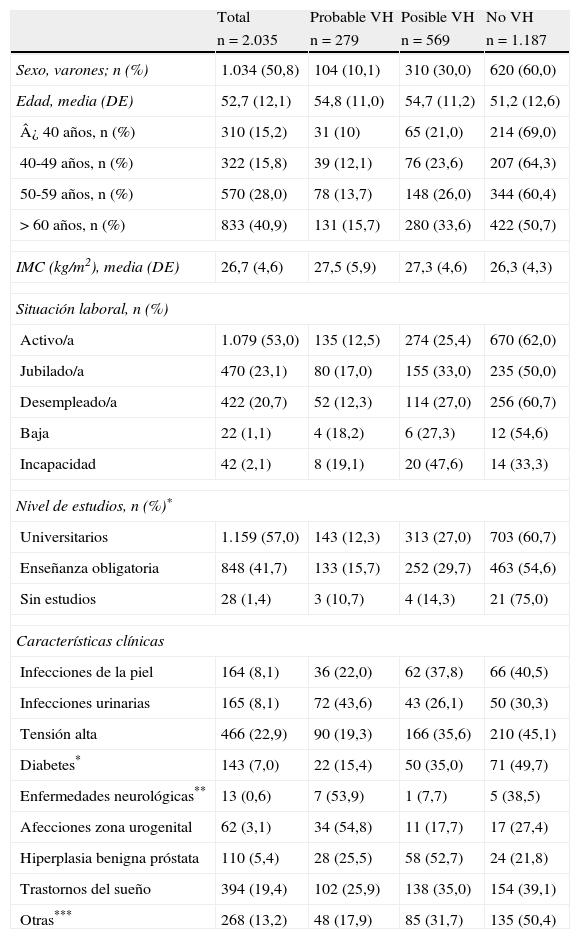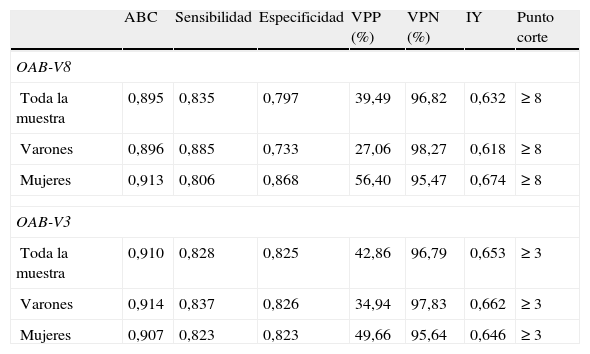Realizar la validación psicométrica en la población española de la escala Overactive Bladder Awareness Tool (OAB-V8), y de su versión abreviada, OAB-V3, para la detección de pacientes con probable vejiga hiperactiva (VH).
Pacientes y métodoEstudio transversal en población general>18 años realizado por vía telemática (Internet) sobre una población representativa de la prevalencia de VH en la población española. Las propiedades evaluadas incluyeron factibilidad, fiabilidad y validez. Los sujetos incluidos fueron clasificados según la probabilidad de VH usando un algoritmo automatizado validado previamente. Se realizó análisis de curvas ROC y se determinaron sensibilidad, especificidad, y valores predictivos positivo y negativo.
ResultadosSe incluyeron 2.035 sujetos, con una edad media+DE de 52,7+12,1 años (50,8% varones). El 13,7% fue clasificado como «Probable»; el 27,9% como «Posible» y el 58,3% como «No» VH. La consistencia interna para las escalas OAB-V8 y OAB-V3 fue alta (0,894 y 0,851 respectivamente), con correlaciones ítem-total asimismo elevadas en ambos casos (0,87-0,88 y 0,71-0,83 respectivamente). Ambas escalas fueron fiables con coeficientes de correlación intraclase de 0,826 (intervalo de confianza del 95%: 0,695-0,901) y 0,828 (intervalo de confianza del 95%: 0,623-0,922), respectivamente. El punto de corte óptimo en la escala OAB-V8 para identificar probable VH fue≥8 puntos (área bajo la curva 0,895; sensibilidad 0,875 y especificidad 0,735), mientras que en la OAB-V3 fue≥3 (área bajo la curva 0,910, sensibilidad 0,828 y especificidad 0,825).
ConclusiónLas escalas OAB-V8 y OAB-V3 resultaron ser herramientas útiles de cribado autoadministrado por vía telemática, factibles, fiables y válidas para la detección de pacientes con probable VH en la población general en España.
To perform the psychometric validation in the Spanish population of the Overactive Bladder Awareness Tool (OAB-V8) scale and its abbreviated version OAB-V3 for screening patients with probable overactive bladder (OAB).
Patients and methodsA cross-sectional study was conducted in a population aged over 18 years, which was representative of the prevalence of OAB in Spain using an online methodology (Internet survey). Psychometric properties included feasibility, reliability, and validity. Subjects were classified according to the likelihood of OAB, using an automated algorithm validated previously. ROC curve analysis was performed, and the sensitivity, specificity, and positive and negative predictive values were also assessed.
ResultsA total of 2,035 subjects with a mean+SD age of 52.7+12.1 years were included (50.8%) men. In total 13.7% were classified as «Probable», 27.9% «Possible», and 58.3% «No» OAB. The internal consistency of both OAB-V8 and OAB-V3 scales was high (0.894 and 0.851, respectively). The item-total correlation coefficients were high; 0.87-0.88 and 0.71-0.83, respectively. Intraclass correlation coefficient for OAB-V8 was 0.826 (confidence interval 95% 0.695-0.901) and it was 0.828 (confidence interval 0.623-0.922) for OAB-V3. The optimum cut-off value of OAB-V8 for detecting probable OAB was≥8 points (AUC=0.895, sensitivity 0.875, specificity 0.735), while for the OAB-V3 it was ≥ 3 (AUC=0.910, sensitivity 0.828, specificity 0.825).
ConclusionBoth OAB-V8 and OAB-V3 scales were considered useful online self-administered screening tools, which were also feasible, reliable and valid for the detection of patients with probable OAB in the general population in Spain.













